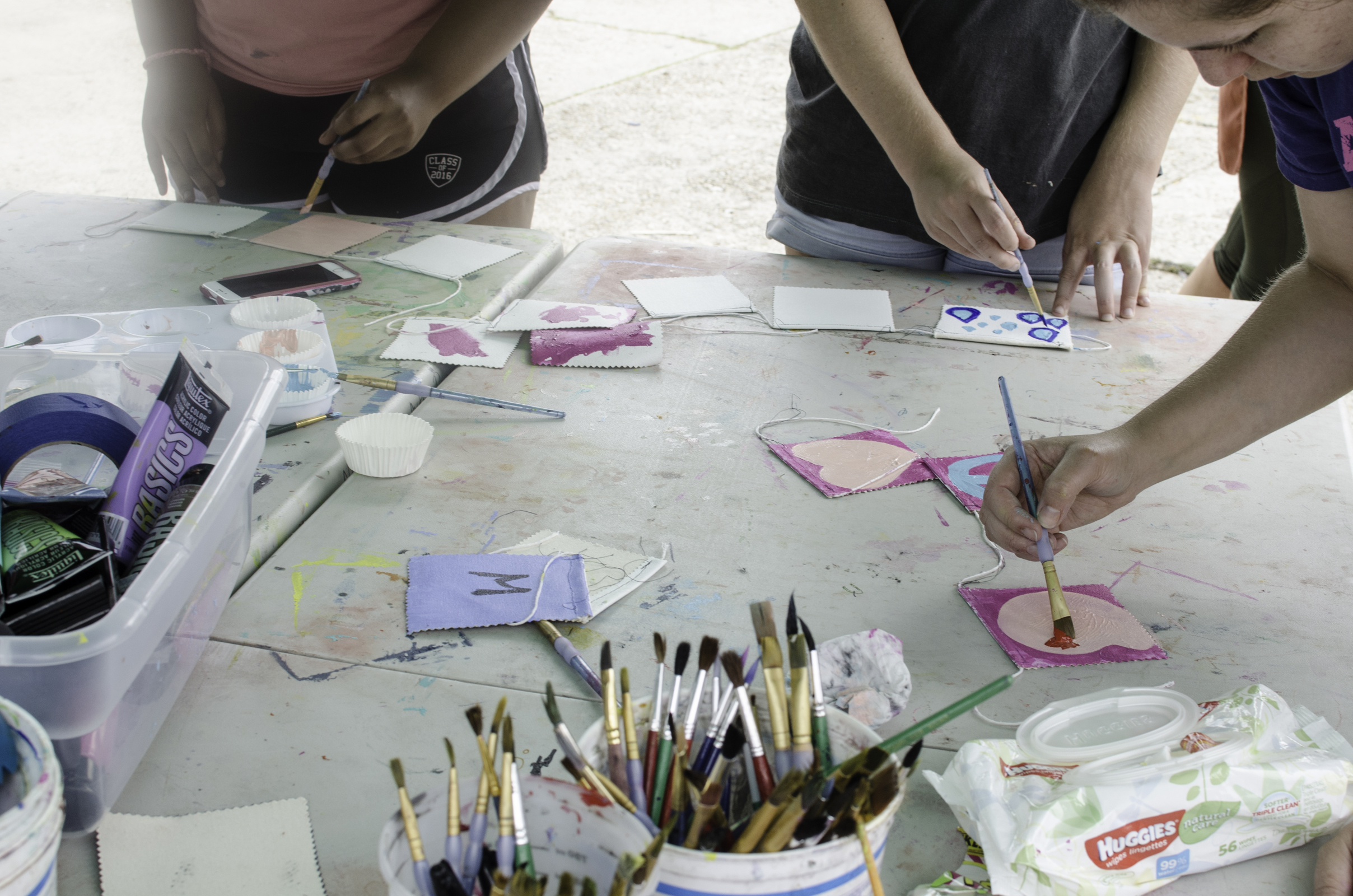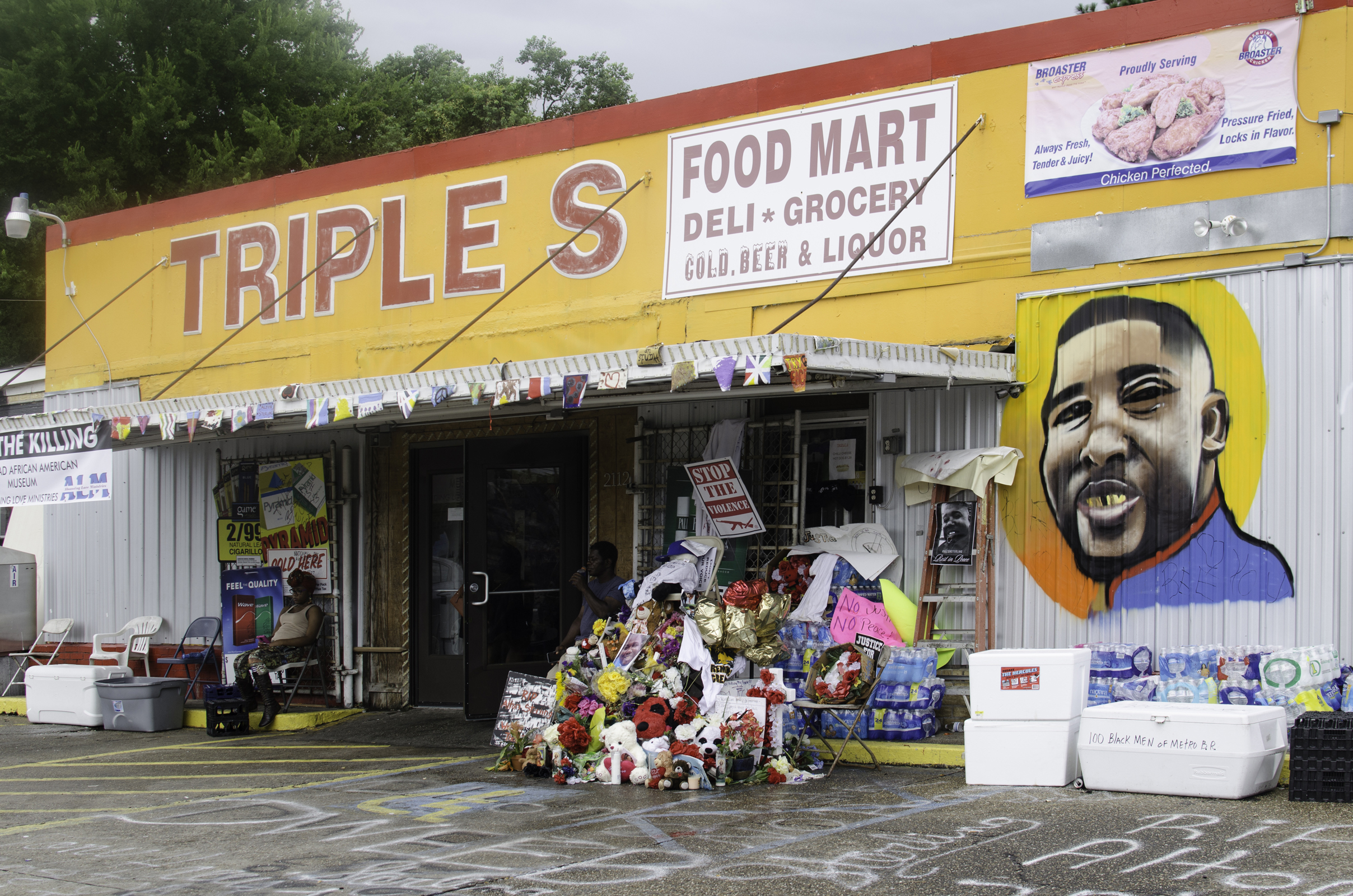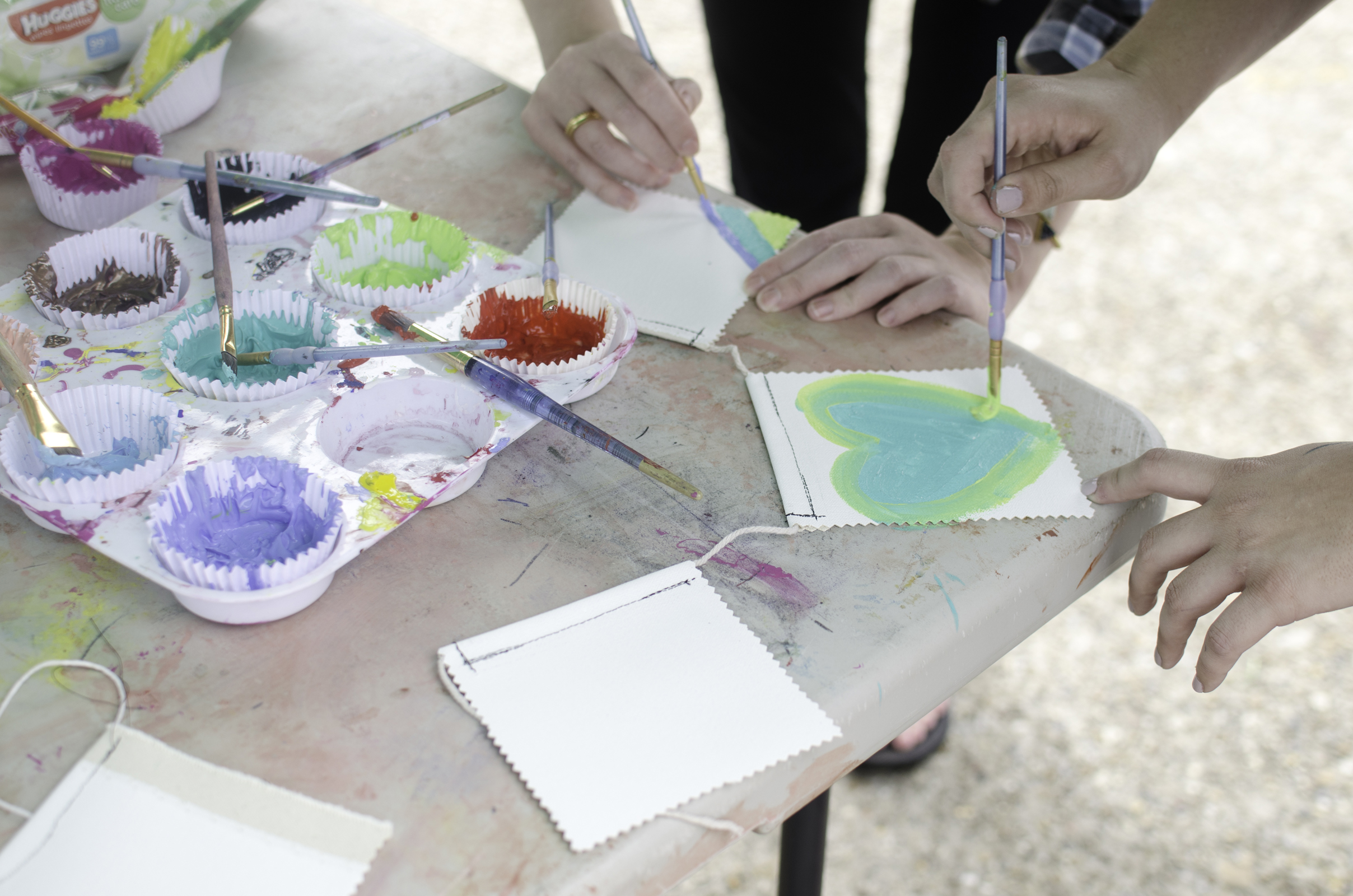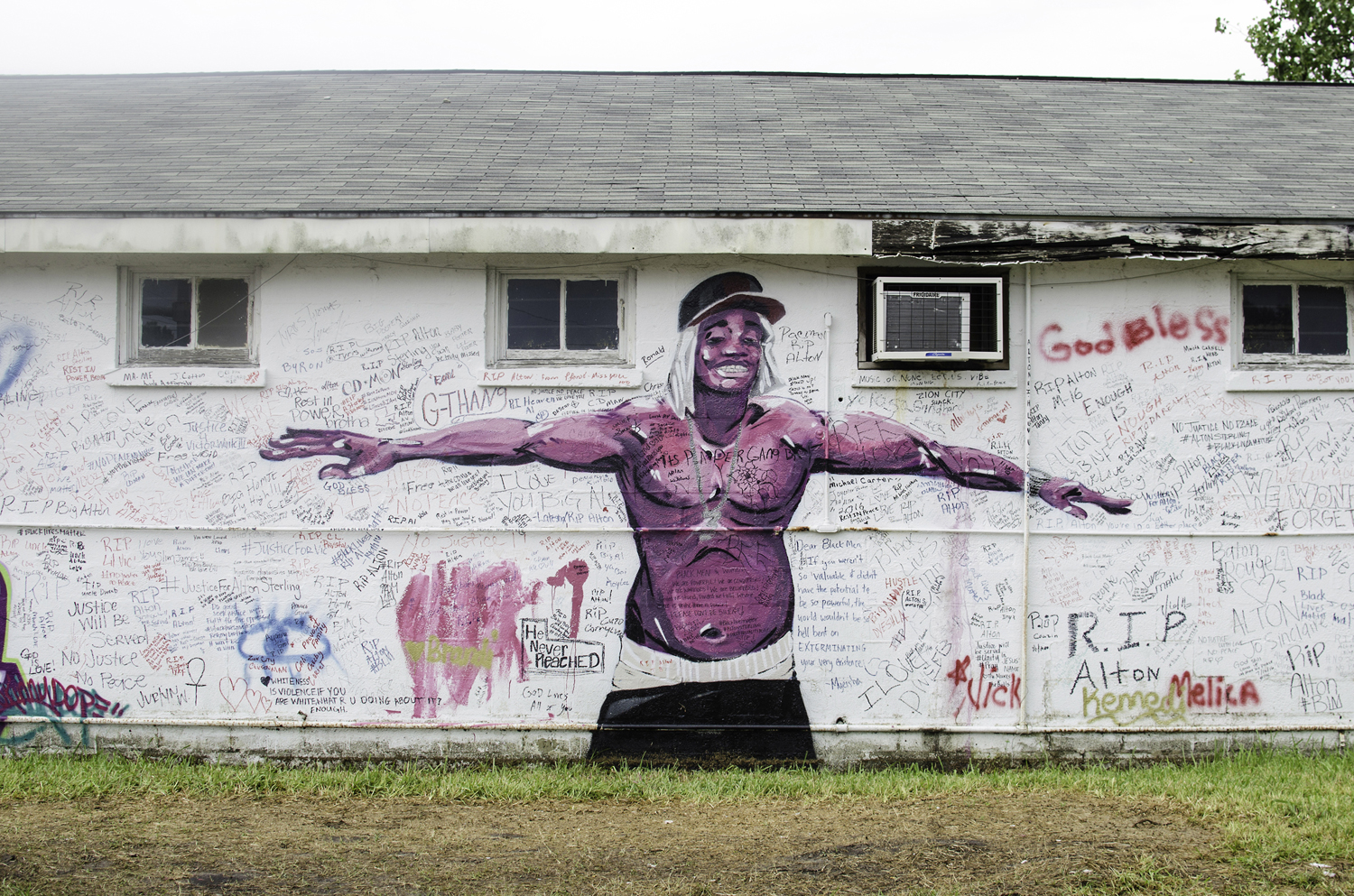
Baton Rouge comes together through art in the wake of Alton Sterling’s death
Before the night of July 5, the Triple S Food Mart looked about the same as every other storefront on North Foster Drive: aluminum siding and a bright yellow facade with red lettering declaring cold beer and liquor. Folks who live in the neighborhood frequent Triple S for a bottle of soda or a pack of cigarettes or just a friendly conversation.
At the front of the store, there now sits a massive pile of gifts, letters and mementos, everything from Wal-Mart-brand bouquets to slowly deflating balloons. There’s a poster with words scrawled across it: “My respects to Big Al the CD Man! Always with his smile!”
 “Big Al the CD Man” was one of the store’s regulars, 37-year-old Alton Sterling. The posters and gifts sit near the spot where he lost his life. After his shooting by local police in the store’s parking lot and the subsequent national outcry over the incident, Triple S has been transformed into an unlikely civil rights landmark.
“Big Al the CD Man” was one of the store’s regulars, 37-year-old Alton Sterling. The posters and gifts sit near the spot where he lost his life. After his shooting by local police in the store’s parking lot and the subsequent national outcry over the incident, Triple S has been transformed into an unlikely civil rights landmark.
|
|
The memorial out front is a piece of art in itself, a growing sculpture. At its peak is a life-sized color photo of Sterling’s face, lifted up to about the towering height from which he might have smiled at you if he were still standing here in his usual spot.
To the right: a mural of Alton Sterling’s face on the front wall of Triple S. He’s still smiling—always with his smile—in the mural by local artist Jo Hines commissioned by The Walls Project. The convenience store wall was offered up by owner Abdullah Muflahi, and here Sterling has been painted with a gold halo around his head.
To the left: the broad white wall of the Denicola’s Furniture warehouse, which owners Michael Gatz and Amy Strother donated to the artistic cause, now emblazoned with another commissioned mural of a black man with his arms outstretched. Hundreds of names and messages in spray paint and permanent marker fill the space around it with condolences, poetry and calls for change.
“When we decided to join hands with the Walls Project [and] present this blank canvas to the public, I wasn’t sure what to expect. … It’s perfect because it’s full of raw emotion and sadness and hope,” Gatz says. “There’s nothing on this wall that’s ‘wrong’ or ‘inappropriate’—because it’s all real.”
It’s art that has brought the community together at Triple S. Shortly after Sterling’s shooting, LSU Museum of Art coordinator of school and community programs Lucy Perera began searching for a way to help local kids and teens work through their feelings on police violence, racism and unrest in their community. The idea she landed on: prayer flags handpainted by kids of the Neighborhood Arts Project, an effort in its fourth year led by Perera to bring art to inner city kids.
Some prayer flags are specific, with “Black Lives Matter” or Alton Sterling’s name painted on them, while others are more abstract, with hearts or blotches of color dabbed on by the youngest artists. While Perera says there’s still a long road to healing for many of these kids, the prayer flag project has opened up discussion and an outlet to process their feelings.
 “There was one little kid around 8 or 9 that works with us down on South Boulevard. We had a long talk,” Perera says. “His sister was friends with Alton Sterling’s son, and he knew the story. And he said, ‘My dad has an unregistered gun. Does this mean my dad’s going to get shot?’ So we talked, and I hope that it allows him to see [this racial division] in a different light.”
“There was one little kid around 8 or 9 that works with us down on South Boulevard. We had a long talk,” Perera says. “His sister was friends with Alton Sterling’s son, and he knew the story. And he said, ‘My dad has an unregistered gun. Does this mean my dad’s going to get shot?’ So we talked, and I hope that it allows him to see [this racial division] in a different light.”
There are people of all races, Perera explains, who are willing to help.
During a trip to Triple S to check on the prayer flags, Perera encountered an activist who helped her secure the flags with zip ties and thanked her for the project. He mentioned how much making flags could mean to children of the neighborhood around the store, so Perera returned days later with tables and a tent to invite nearby residents of all ages to make their own flags.
Saki Puckett, 18, lives just east of Triple S and has been working with the Neighborhood Arts Project since she was 15. She’s here now, under the tent in the convenience store parking lot, painting.
“It’s important to come out here and do the prayer flags to show the kids that not everything has to end violently,” Puckett says.
A black man in his 30s wearing a baseball cap with Sterling’s name written on it stands at the table painting a set of prayer flags that read “GOD DON’T SLEEP.” Around his wrist are a few pink flower-shaped barrettes clipped to a hair tie, and when asked if he has a daughter, he answers that he just loves doing his niece’s hair.
“This is my heart,” he says, pointing at the flags with his paintbrush. “If you don’t have love and God, what do you got?”
Behind him, another man steps back to take a cell phone picture of the group as they paint their prayer flags. When a white person tries to duck out of the photo out of courtesy, he waves her back in.
“Get back in there,” he says, laughing. “Everyone under this tent is family.”
This article was originally published in the August 2016 issue of 225 Magazine.
|
|
|
